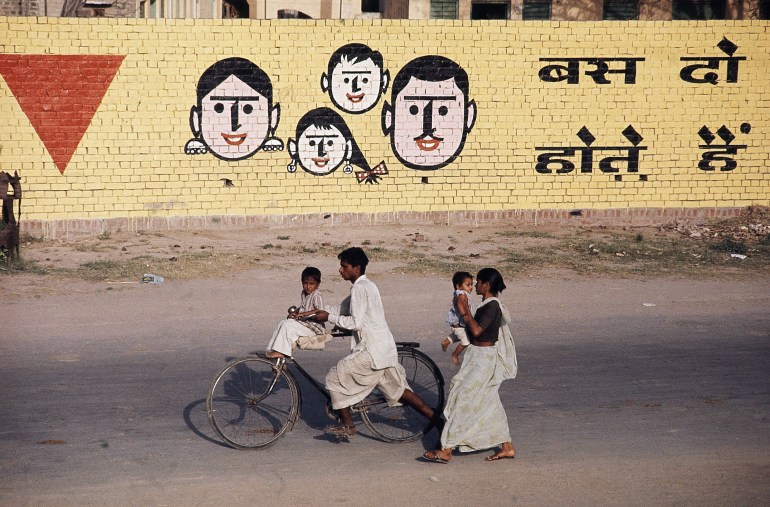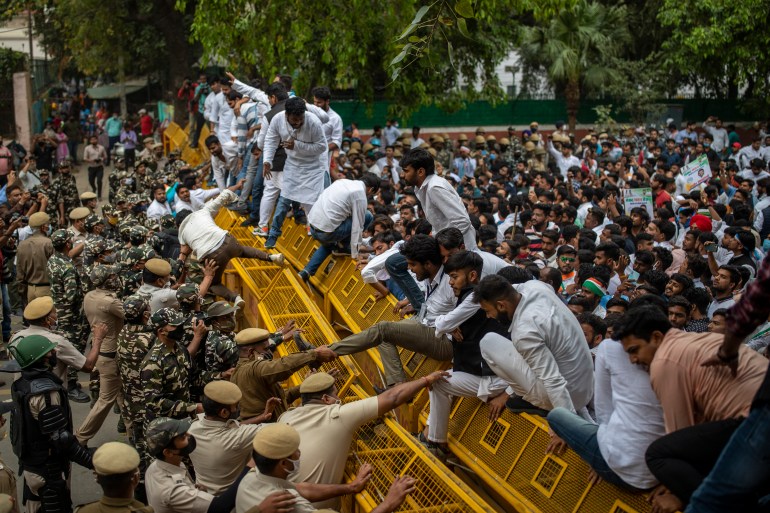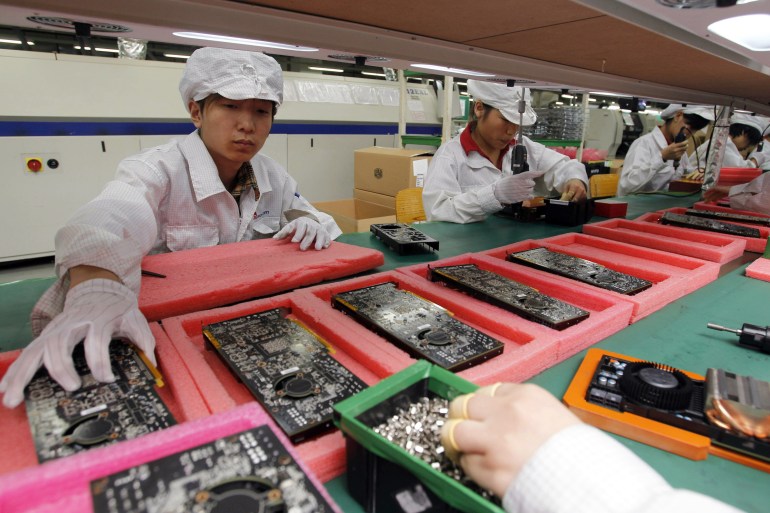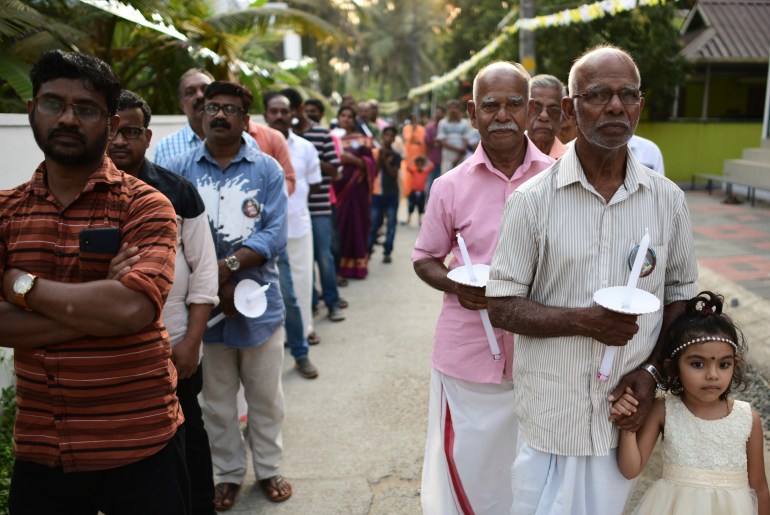World’s largest population: Will India gain or lose?
India has the world’s largest workforce. But without enough good jobs, that unmatched advantage could prove a disaster.

For decades, India ran family planning programmes aimed at curbing its population growth amid limited resources.
Then, as the Indian economy took off after liberalisation in the 1990s, the country’s policymakers changed tack: The country’s vast, young labour pool, New Delhi argued, was a “demographic dividend” that would pay out handsomely for the Indian economy.
Keep reading
list of 4 items‘We need you’: Solomon Islands’ support for US agency’s return revealed
Why are nations racing to buy weapons?
Parallel economy: How Russia is defying the West’s boycott
Now, that promise is set to be tested like never before. India is poised to overtake China to become the world’s most populous country, with more than 1.4 billion citizens, in April, the United Nations has predicted.
Though India’s birth rate has slowed down in recent years, the country has a larger working-age population in absolute numbers (1.1 billion) and proportion (75 percent of the population) than any other major economy.
Meanwhile, China is ageing, with its population declining in 2022 for the first time in more than 60 years. Its economic growth, which had skyrocketed at an average of nearly 10 percent a year since 1978, is now anaemic: The country’s gross domestic product (GDP) grew just 3 percent in 2022, and even by Beijing’s own estimates, is expected to increase by just 5 percent this year.
The disruptions of COVID-19 and rising geopolitical tensions with the West have also made industries and investors consider destinations other than the world’s second-largest economy for their supply chains and plants.
So could India’s population and potential labour force make it the next big economic story — one capable of capitalising on China’s economic struggles? Or does the world’s largest democracy have an Achilles heel that could derail those dreams? Al Jazeera asked leading economists and analysts these questions.
The short answer: India’s youth bulge is a double-edged sword. To gain from it, India will need to create enough jobs for the millions who enter its workforce every year — a challenge at which it is currently failing. For that, India needs to attract global investments. The window of opportunity is shrinking, and unless India moves quickly, its demographic dividend could easily turn into an unemployment nightmare.

A big population: boon or bane?
Soon after independence, India — its population at the time was about 350 million people — adopted the world’s first national family planning programme in 1952. The focus at the time was on encouraging families to have two children.
But by the 1960s, the Indian government under former Prime Minister Indira Gandhi started taking more aggressive — even repressive — measures to control birth rates, which stood close to six children per woman, compared with two at present. The country’s economic growth was slow at the time — it averaged 4 percent from the 1950s to until the start of the 1990s. A surging population was seen as a problem, Mahesh Vyas, the chief executive of the Mumbai-based data research firm Centre for Monitoring Indian Economy (CMIE), said.
“The greatest obstacle in the path of overall economic development is the alarming rate of population growth,” India’s health and family planning minister S Chandrasekhar said in 1967. The West, which viewed Indian democracy as a counterweight to Chinese communism, agreed. The World Bank loaned India $66m for sterilisation programmes, while the United States linked its food aid to a hungry India to the country’s success at population control initiatives.
In the 1970s, India carried out forced sterilisation on millions of men, thousands of whom died from botched surgeries.
Then, in the 1980s and 1990s, India began opening up its economy to the private sector. The country’s growth rate picked up, first to 5.5 percent through the 1990s, and then beyond 7 percent on average from the late 2000s.
Policymakers began viewing a growing young population in the form of the so-called demographic dividend — when a majority of a country’s population falls within the working ages (15-64 years) — as an engine for further economic development.
In fact, according to Vyas, that dividend has already helped India’s economic growth since the 1990s. “In the 1990s, India succeeded quite well in moving people from farms to factories,” Vyas told Al Jazeera. “This was a cultural change caused by policy interventions and helped by the demographic changes.”
In addition to a large workforce, a significant young population could, in theory, also become a source of investments in the future, Vyas said, if it earns well and saves.
“Many studies have shown that the economic growth that has happened in many other parts of the world, historically and even recently, is largely attributable to the demographic dividend,” he said. “So, we in India have this benefit available to us.”
Yet for that young workforce to earn and save well, it needs enough well-paying jobs designed to serve the modern economy. That’s increasingly proving a struggle for India.

Ticking time bomb
India’s official unemployment levels touched a 45-year-high of 6.1 percent in 2017-18, jumping up from 2.7 percent from the previous estimate of 2011-12, according to official data. The government’s annual jobs data suggests that unemployment levels improved to 4.1 percent in 2021-22.
But other data suggests that India’s jobless numbers are much higher. According to Vyas’s CMIE, India’s unemployment rate in March stood at 7.8 percent, and was even higher (8.5 percent) in urban India, home to better-paying non-farm jobs.
Close to five million workers enter the labour force every year in India, according to an analysis of the official estimates. The government’s own production-linked incentive scheme for selected sectors is expected to create six million jobs in five years – which will not be sufficient to cater to India’s growing labour market.
“Unemployment has been one of the biggest challenges for the Indian economy in the past two decades and it’s not showing signs of improvements,” said Himanshu, an associate professor in economics at New Delhi’s Jawaharlal Nehru University (JNU), who goes by one name.
Meanwhile, according to a World Bank report, investment growth in India has almost halved from an annual average of 10.5 percent between 2000 and 2010 to 5.7 percent between 2011 and 2021. The report attributed several factors to this decline in investment growth, ranging from worries about power supplies and road and rail networks to the bureaucratic demands placed on businesses.
In many ways, this is an indictment of Prime Minister Narendra Modi’s “Make in India” policies that have been pitched as a means to turn the country into a global manufacturing hub and investment magnet.
“We haven’t seen good indicators as far as India’s ability to use the young population into productive employment,” Himanshu told Al Jazeera.
COVID-19 lockdowns hit 40 million workers from rural India who were working in cities, forcing a giant internal migration wave as they returned to their villages. This, coupled with an underwhelming revival in the jobs market after the pandemic waned, has led to a situation where the share of farm jobs in India’s total employment has been increasing, while the proportion of manufacturing sector jobs has been declining.
That move from cities to villages is a reversal of the successful strategy that worked for India starting in the 1990s, when in Vyas’s words, the “demographic dividend coupled with more liberal and intensive efforts to drive investments helped” pull the economy up. It also suggests disguised unemployment, since almost 45 percent of the country’s workforce is employed in a sector that contributes roughly one-fifth to its total economy.
“More people are actually joining the agricultural sector compared to the non-agricultural sector,” Himanshu said, “which really shows that we are going to fritter away the advantage that demographic dividend has given us.”

Competing for China-plus-one
Not everyone is as pessimistic. As companies look at diversifying their businesses and investments beyond China, India is well positioned to take advantage, said Radhicka Kapoor, visiting professor at New Delhi-based think tank Indian Council for Research on International Economic Relations.
China is ageing so quickly that the share of its population above the age of 60 is set to increase from 20 percent at present to 30 percent by 2035. Vietnam, which in recent years has emerged as a manufacturing hub, is also ageing rapidly. India has a slightly higher segment of its population in the 15-64 age group than the Philippines, another country long seen as a possible contender for a piece of China’s manufacturing pie.
A large working-age population makes India attractive, not just from the labour market perspective but because the country could act as a large market for goods and services, Kapoor told Al Jazeera.
Some signs of that allure are already visible.
Taiwanese contract manufacturer Foxconn has reportedly won an order to build a factory in India to produce Apple’s wireless earphones, known as AirPods. Last year, Foxconn signed an agreement with Indian mining giant Vedanta to invest $20bn in setting up the country’s first private semiconductor and display production plant in the state of Gujarat.
“At the same time, a lot of investors are also looking at skills and a lack of skilled workforce can really hurt India’s prospects,” Kapoor warned. While India has “very highly skilled labour in the services sector” — including areas like information technology, where the country is a global leader — its workforce lacks the training needed for the high-end manufacturing industries “we seek to attract,” she said. “This has been our legacy issue as we have traditionally underinvested in the human capital.”
That failure could return to haunt India very soon, economists caution.

Small window
India’s workforce will not remain young forever. With fertility rates falling, India’s working-age population (20-59 years) is expected to peak at 59 percent of the overall population by 2041, according to projections made in the country’s economic survey of 2018-19.
“We have a small window ahead of us. I don’t think the population figures are so important as establishing what you have to do with the demographic dividend,” Himanshu at New Delhi’s JNU said.
As things stand, countries like Bangladesh and even Vietnam — despite its ageing population — stand to gain more than India when it comes to attracting investments and creating jobs, according to CMIE’s Vyas. In fact, public investment in Bangladesh, at 6.5 percent of GDP between 2011 and 2020, was double India’s public investment-to-GDP ratio, according to the World Bank.
“These countries offer a stable business environment and are a lot more quick in decision-making,” Vyas said. “Our biggest problem is unpredictability. For instance, if a business which has taken a bank loan goes bad and the loan becomes a non-performing asset, it is stigmatised really hard and hounded.
“The perception that companies can be hounded even when the case is not proven will make industry averse from making long-term investments,” Vyas said.
India’s government needs to act swiftly to change that perception, and ensure that there are incentives to create sufficient good quality jobs, according to economists.
The country has a “once-in-a-lifetime opportunity”, Kapoor said. To cash in on that, it needs to strengthen apprenticeship programmes and expand partnerships between public and private sector to improve the skills of workers, she said.
Vyas fears the opportunity could equally develop into a crisis. India must “ramp up investments and absorb all the people into the workforce,” he said. Otherwise, its much-vaunted dividend, he warned, “can turn into a demographic disaster”.